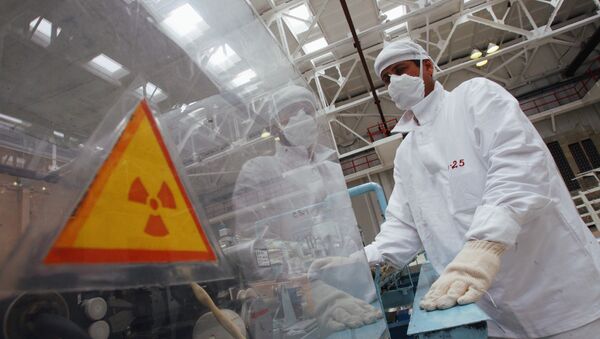HUNTERSTON (SCOTLAND), October 7 (RIA Novosti), Mark Hirst – Claims by British company EDF Energy that cracks inside one of reactor cores at Hunterston B in a Scottish county were safe, are "overly reassuring" and the reasons for the cracking and any associated risk remain unknown, one of the world's leading nuclear safety experts told RIA Novosti on Tuesday.
With a career spanning five decades, including leading the nuclear risk assessment team during the raising of the damaged Russian nuclear submarine Kursk in 2001, John Large told RIA Novosti, "I disagree with the somewhat overly reassuring opinions of [EDF Energy] and I note that this cracking has to be taken into account with a number of other graphite degradation processes and outcomes, particularly the graphite mass loss via radiolysis."
During routine maintenance in August, operators at the nuclear plant discovered cracking in some graphite bricks in the core of Reactor 4 at the Hunterston B nuclear plant in the Scottish Ayrshire county, but it was not until Monday that the problem was made public.
But Large, who runs a nuclear safety consultation company, Large Associates, told RIA Novosti the issue was not a new one, and said he first studied and reported on the problem in 2006.
His conclusions, which were later backed by the nuclear safety regulator, Office for Nuclear Regulation (ONR), were that the processes leading to the cracking were not fully understood.
In the wake of Large's 2006 report, the ONR noted, "…if there are no historical data to indicate how degradation develops with time there is, I believe, an increased likelihood of increased risk should we agree to continued operation."
Large told RIA Novosti that the problem of cracking bricks within the core of the reactors was first identified following maintenance checks during 2002 through to 2004.
"The main area of concern in 2006 was the difficulty in locating cracked bricks," Large told RIA Novosti. "This is because of the limited time during a servicing outage to access all of the fuel and control rod channels - about 240 in total - that pierce through the core and the fact that the cracking develops on the outer face keyway locality which is not directly accessible from within the channel."
"So whereas only one or two cracks might be actually detected, this presence of these cracks is a clear indication that other cracks have developed and exist but which are beyond detection," Large added.
Large added that an indication of how serious an issue the problem was is reflected in the ONR's ongoing research and development program and the fact plant operators, EDF Energy, claims to have 200 staff and engineers working to find a solution to the problem.
Large told RIA Novosti that the problem was likely to be happening in all 14 of the UK's Advanced Gas-cooled Reactors (AGR).
"Little progress seems to have been made in the understanding of why and at what rate the graphite bricks are degrading and cracking and, particularly, how this effects the residual strength of the individual bricks and overall core assembly in the event of a sudden pressure change in the reactor gas circuit," Large told RIA Novosti.
"Incidentally, the only other nuclear power plant design of commercial power output size that incorporates a graphite moderator is the RBMK (Reaktor Bolshoy Moshchnosti Kanalnyy) Soviet unit - of Chernobyl notoriety - although, unlike the AGR, the RBMK core is not highly pressurized and subject to this residual strength problem," Large added.
"The RBMK core can also be repaired and replaced in situ unlike the AGR core which is almost entirely inaccessible for any maintenance or repair operation."
In a statement EDF Energy's Director of Nuclear Operations, Brian Cowell said, "What we have found here is that our models and mathematical assumptions are absolutely underpinned by our findings. Therefore, they have revalidated again the fact that we have got these massive safety margins and the (reactor) cores will behave as we have predicted in extreme events, which is exactly what we want."
"They are safe," Cowell added.

